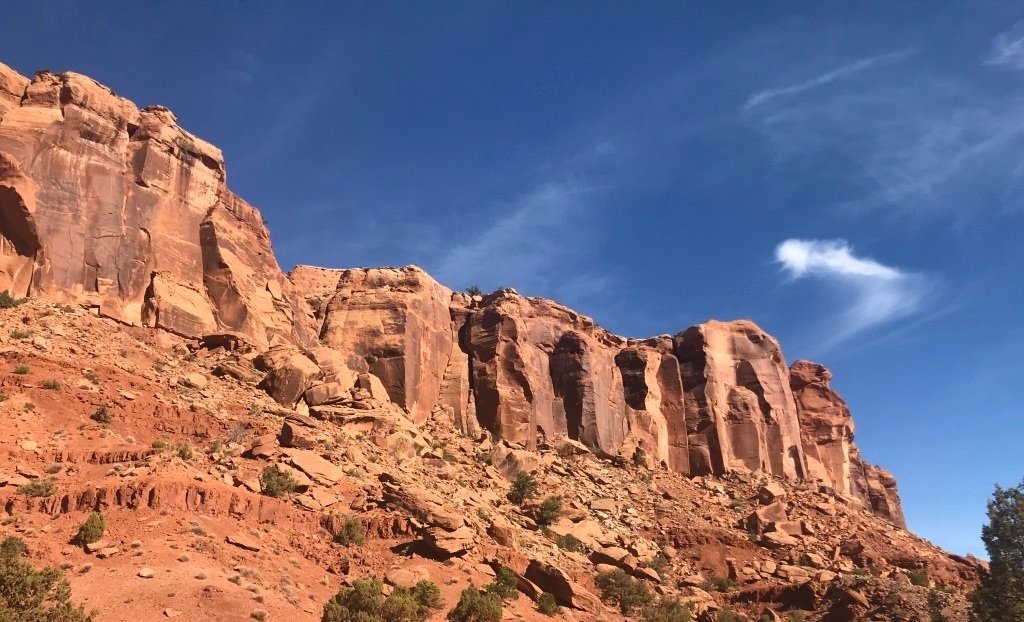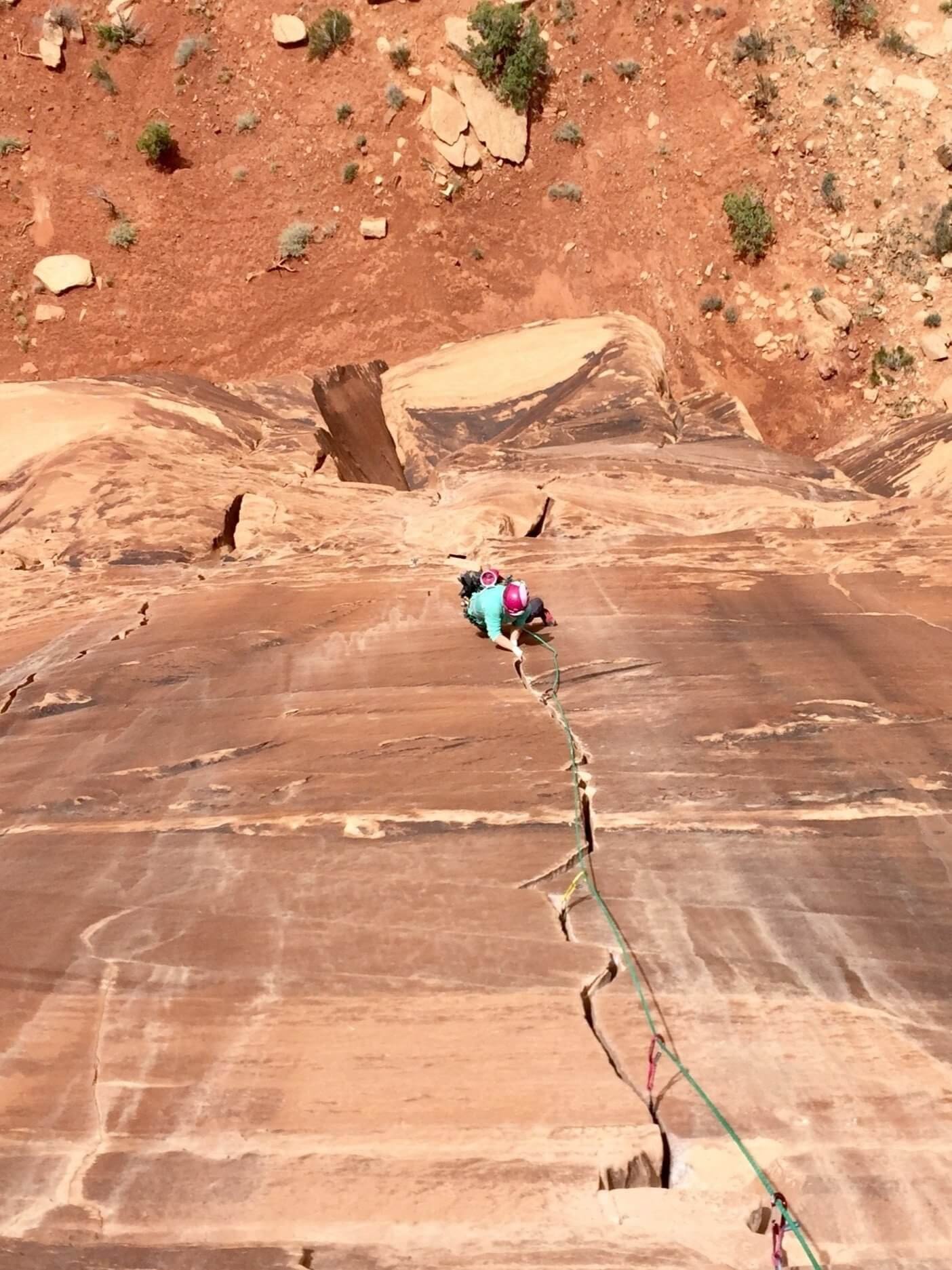
Grand Junction Rock Climbing
Hone your rock climbing techniques, climb a desert tower and enjoy a plethora of climbing set in a beautiful and isolated corner of Colorado. Nestled against the stunning backdrop of the Colorado National Monument, Grand Junction is an epicenter for rock climbing enthusiasts of all skill levels. Skyward Mountaineering is co-owned and operated by longtime local, Vince Anderson who provides a unique and intimate knowledge of the area’s best rock climbing. From our base of operations we have access to a variety of guided climbing adventures catering to your experience and aspirations. Let us help you unlock your full climbing potential in this breathtaking location.
Truly a great basecamp for rock climbing, hiking mountain biking, and river sports, Grand Junction is a perfect family friendly destination. Consider a multi-day trip combining multipitch climbing on the granite at Unaweep Canyon, single pitch crack climbing in Escalante Canyon and desert towers in Colorado National Monument. Additionally, only a short drive away, the Black Canyon beckons climbers looking for more challenge.

Multipitch rock climbing
Routes ranging from 5.8 to 5.12
No previous experience required, routes for all abilities
Full day (8 hours)
Mid February - late November
Grand Junction, Colorado
4,583 ft / 1,396 m
Where do you want to climb in Grand Junction?
Colorado National Monument
Multi-pitch desert towers
Unaweep Canyon
Beginner to advanced toproping and multi-pitch granite
Escalante Canyon
Toprope crack climbing
Book a rock climbing trip in the Grand Junction desert
-
The secluded red cliffs of Navajo sandstone rise above the valley in Escalante Canyon, showing off splitter cracks and a distinct lack of crowding despite it’s beauty and fun rock climbing opportunities. Similar to nearby Indian Creek in Utah, Escalante Canyon is a desert crack climbing dream, walls are lined with cracks of varying sizes providing climbers with a truly natural form of rock climbing. However, unlike the famous Indian Creek, Escalante Canyon is mostly unknown and paired with the shorter approaches this zone is a fantastic classroom for honing your crack climbing technique. Most of the walls face south so Escalante Canyon is best during cooler temperatures and can be a wonderful early spring and late fall rock climbing destination.











Frequently asked questions
Below are answers to common questions about rock climbing in Grand Junction with Skyward Mountaineering:
-
Grand Junction has several incredible rock climbing zones with varying types of geology, styles of climbing, and difficulty levels.
Unaweep Canyon is a great granite crag for beginner climbers with a good level of fitness who want to learn the sport for the first time or intermediate to advanced climbers who want to refine their technique. Routes range from single pitch to 5 pitches tall, most approaches are around 15-20 minutes.
Escalante Canyon is a great spot for intermediate to advanced climbers who want to hone their crack climbing technique. The routes in Escalante Canyon start around 5.10 so this location is not well suited to beginner climbers, but route difficulties go up to 5.13 so there are plenty of options for climbers to practice their techniques with the security of a toprope or push themselves on lead with expert coaching from their guide.
Colorado National Monument has several great single pitch crack climbing crags and is best known for adventurous multipitch desert towers. Otto’s Route has a few moves of steep climbing on the headwall and is graded 5.8+, it is a great introductory multipitch route for newer climbers as well as experienced climbers who want a unique adventure. Other towers in Colorado National Monument are best suited for experienced climbers who want both adventure and challenging rock climbing. Routes range from 5.10+ to 5.12.
-
Yes! Skyward Mountaineering puts a lot of value in working with you to personalize every guided climbing trip, so details like the start time, hiking pace, photos, climbing instruction, bonus pitches afterwards, etc can all be adjusted to meet your specific goals. Your guide will reach out in the days before the climb to discuss these logistics, please let them know if you have any questions or specific requests.
Additionally, our administrative staff are climbers and guides too and we’re here to support you through the whole process. If you have any questions before booking your guided climb or before the trip starts please reach out to us and we are happy to answer your questions.
-
Welcome to the world of rock climbing, you’re life will likely be different from now on. Grand Junction and the surrounding West Slope is an awesome spot for a rock climbing vacation. We highly recommend a 3-4 day itinerary to optimize your opportunity rock climb outdoors in Grand Junction. We will spend the first two days covering movement skills and fundamental climbing systems so you can build your confidence and be a self-sufficient climber. We’ll then sample some of the multipitch climbing around Grand Junction so you can enjoy the exposure and classic croutes.
Only interested in a single day of rock climbing? That’s totally fine too, there are plenty of good beginner options in Grand Junction and we’ll find the best spots for you to learn how to rock climb and have fun!
-
We guide toproping in Grand Junction at a maximum of 4 climbers per guide. If you would like to climb with a group larger than 4 people we can add a guide so everyone is able to climb together. Contact us to discuss a rock climbing trip with groups larger than 4 people.
On multipitch routes, such as in Colorado National Monument or Unaweep Canyon, we climb at a maximum of 2 climbers per guide, but similarly can add another guide for additional climbers so you can all climb together.
-
We have a detailed equipment list to help you prepare and pack for your trip. If you have questions about any of the gear please let us know, we’re happy to help make recommendations or clarify.
Skyward Mountaineering provides all of the technical group climbing equipment, this includes ropes, anchor material, protection, etc. Many of clients are experienced rock climbers and prefer to use their own equipment, as such we only have a small amount of personal equipment for climbers to use. Please let the admin staff or your guide know ASAP if you expect to borrow personal climbing equipment such as backpacks, harness, helmet, belay device, carabiners, personal tether, etc. We do not have a fleet of rock climbing shoes, so this piece of gear is often not included, but again let us know and we can try our best to help.
-
The best weather for rock climbing in Grand Junction is spring and fall. Temperatures are moderate and rain events are rare. It is also possible to rock climb sunny aspects during the winter though occasional storms pass through the mountains around GJ and cold windy conditions are possible. The summer is often blazing hot and though it’s possible to climb shady aspects, we recommend restarting climbing in Grand Junction around September at the start of fall.
-
With granite in Unaweep Canyon and the south facing aspect getting plenty of sunshine, it’s reasonable to climb right after a rain event (or even after a few hours to let snow melt in the winter). The sandstone climbing areas in Grand Junction often require a 24 hour period to let the rock dry out though as the rock is more porous and fragile.
In the event of rain or snow making climbing in Grand Junction untenable we may have to reschedule. This rescheduling will depend on how much rain occurs, whether the sun comes out, and what the wind speed/direction is. Thankfully, it’s rare that we have to cancel or reschedule a climb due to weather.
Our guides and office staff will work you to coordinate rescheduling, if necessary. For more information on our cancellation policy, please see our terms and conditions and contact us with any other questions.
-
If you know what dates you want to climb in Grand Junction, you can book your trip directly on our website. You can also get in touch to discuss your goals and ask any questions, we’re happy to help and send you a custom booking.
Though we may have availability for last minute trips, please always reach out and ask, we highly recommend booking your trip at least 2 weeks in advance so we can guarantee your guide’s availability and ensure that you are confirmed with all the logistics.




